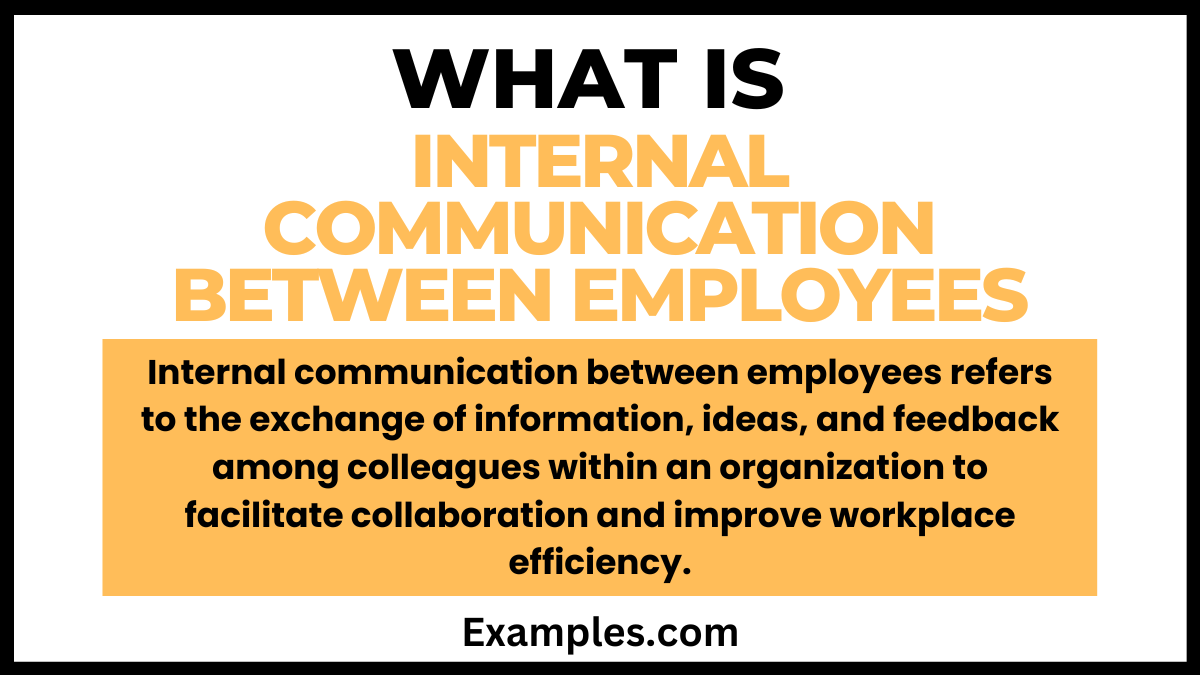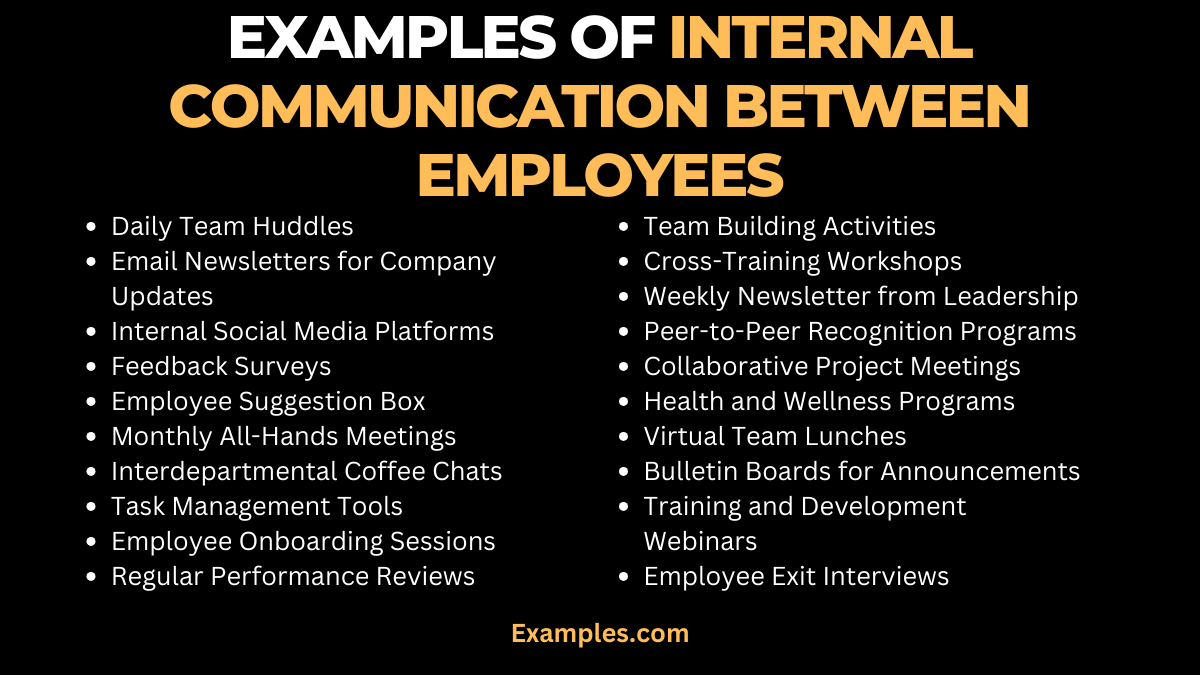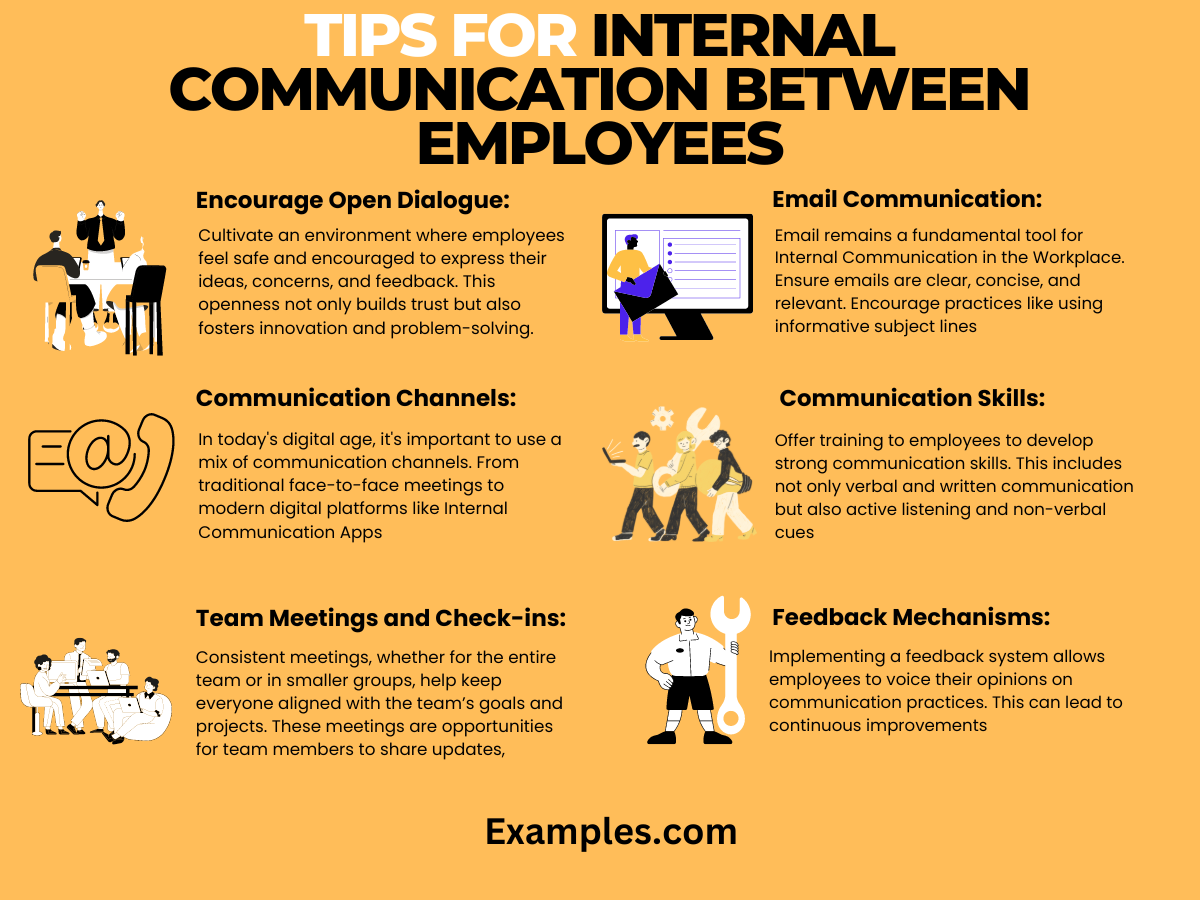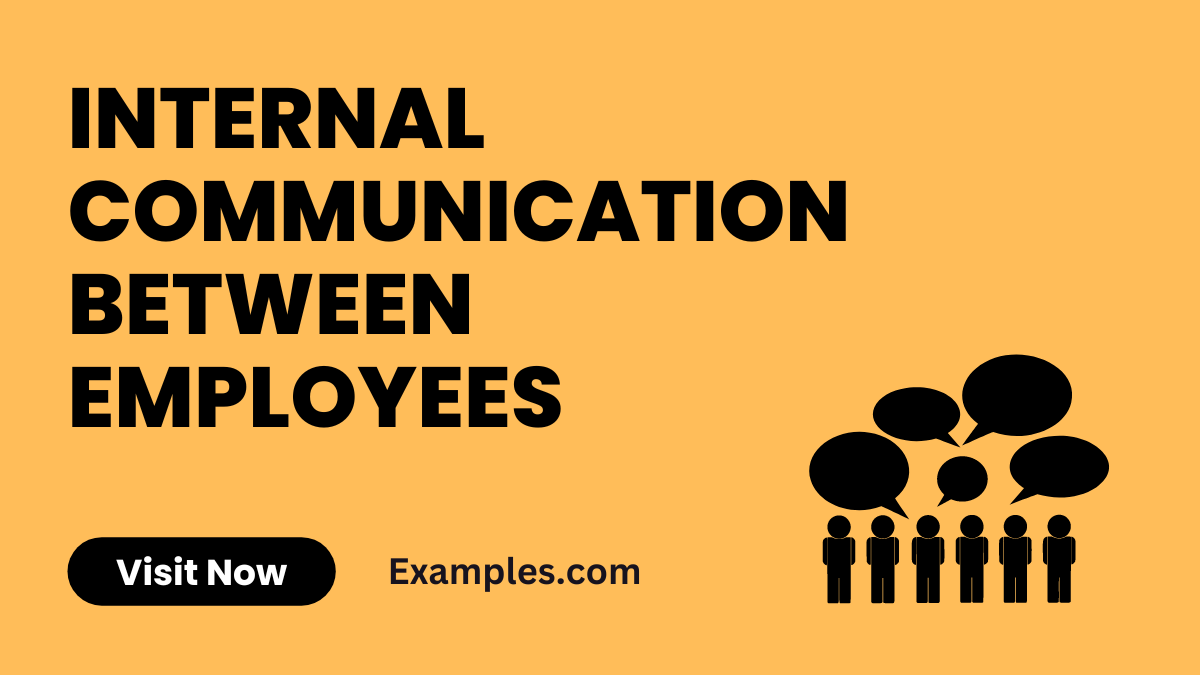19+ Internal Communication between Employees Examples
Explore the realm of Internal Communication between Employees in this insightful guide, which is rich in practical Internal Communication Examples. This resource illuminates the paths to fostering open and efficient communication among staff members. It delves into a variety of strategies, from traditional face-to-face interactions to innovative digital tools, aiming to enhance team collaboration, boost morale, and strengthen the overall fabric of workplace relationships.
What is Internal Communication between Employees? – Definition

Internal Communication between Employees refers to the exchange of information, ideas, and feelings among staff members within an organization. This type of communication can take various forms, from informal chats by the water cooler to formal team meetings and emails. It’s all about how employees talk to each other, share knowledge, and collaborate on projects. Effective internal communication among employees is crucial for fostering a cohesive work environment, enhancing team collaboration, and ensuring that everyone is aligned with the organization’s goals. It forms a vital part of Internal Communication Functions and plays a significant role in Internal Communication in the Workplace.
20 Examples of Internal Communication between Employees
Discover the diverse landscape of Internal Communication between Employees through these 20 distinct and effective examples. Each one illustrates a unique way in which employees can communicate, share information, and collaborate within an organization. These examples span various communication forms, from digital platforms to in-person interactions, highlighting Internal Communication Techniques that enhance understanding, cooperation, and productivity in the workplace.

- Daily Team Huddles: Short, daily meetings to discuss daily goals and updates.
Example: “In today’s huddle, let’s quickly go over our main priorities and any pressing issues.” - Email Newsletters for Company Updates: Regular newsletters to keep employees informed about company news.
Example: “Check out this month’s newsletter for important updates and employee achievements.” - Internal Social Media Platforms: Platforms like Workplace by Facebook to share updates and celebrate milestones.
Example: “Congrats to Team A for hitting their quarterly targets! Shared on our internal social platform.” - Feedback Surveys: Anonymous surveys for employees to provide feedback.
Example: “Please fill out this survey to share your thoughts on our current project management process.” - Employee Suggestion Box: A physical or digital space for employees to offer ideas.
Example: “We value your suggestions; feel free to drop your ideas in the suggestion box.” - Monthly All-Hands Meetings: Company-wide meetings to discuss achievements and future plans.
Example: “Join this month’s all-hands meeting to hear about our latest company developments.” - Interdepartmental Coffee Chats: Informal gatherings to encourage interaction between different departments.
Example: “Let’s meet for a coffee chat next week to discuss cross-departmental collaboration opportunities.” - Task Management Tools: Using tools like Asana or Trello for task updates and collaboration.
Example: “I’ve updated the task status on Trello; please check and acknowledge your next steps.” - Employee Onboarding Sessions: Sessions to introduce new employees to company culture and policies.
Example: “Our onboarding session will help you understand our company values and your role.” - Regular Performance Reviews: Scheduled reviews to discuss employee performance and goals.
Example: “During your performance review, we’ll discuss your progress and set goals for the next quarter.” - Team Building Activities: Activities designed to improve team collaboration and communication.
Example: “Join our team-building activity this Friday to strengthen our team dynamics.” - Cross-Training Workshops: Workshops where employees learn about different roles within the company.
Example: “These cross-training workshops are great for understanding the challenges of other departments.” - Weekly Newsletter from Leadership: Leadership sharing company visions and updates weekly.
Example: “In this week’s leadership newsletter, we’ll discuss our strategic goals for the year.” - Peer-to-Peer Recognition Programs: Programs for employees to acknowledge their colleagues’ contributions.
Example: “Nominate a deserving team member in our peer-to-peer recognition program this month.” - Collaborative Project Meetings: Regular meetings to discuss ongoing projects and brainstorm solutions.
Example: “In our next project meeting, let’s brainstorm potential solutions for our client’s feedback.” - Health and Wellness Programs: Initiatives focusing on employee health and well-being.
Example: “Participate in our health and wellness program to enhance your work-life balance.” - Virtual Team Lunches: Online lunches for remote teams to socialize and catch up.
Example: “Join our virtual team lunch to share your experiences and connect with the team.” - Bulletin Boards for Announcements: Physical or digital bulletin boards for important notices.
Example: “Check the bulletin board for the latest safety protocols and compliance updates.” - Training and Development Webinars: Webinars for continuous learning and professional development.
Example: “Don’t miss our upcoming webinar on the latest industry trends and skills.” - Employee Exit Interviews: Conducting exit interviews to gather feedback and insights.
Example: “Your exit interview will help us understand your experience and how we can improve.”
These Internal Communication Examples showcase a range of methods and approaches that are instrumental in building a communicative, transparent, and collaborative workplace, vital for any thriving organization.
Types of Internal Communication Between Employees
Understanding the Types of Internal Communication Between Employees is crucial for fostering effective workplace relationships and a productive environment. Here are the key types:
- Formal Communication: This includes official announcements, policies, and structured meetings. Formal communication often follows a set pattern and is essential for maintaining clarity and consistency in important messages.
- Informal Communication: Casual conversations, impromptu discussions, and social interactions fall under this category. Informal communication strengthens relationships and can lead to creative problem-solving.
- Vertical Communication: This refers to the communication that flows up and down the organizational hierarchy. It includes directives from management and feedback from employees, playing a crucial role in organizational functioning.
- Horizontal Communication: Communication among employees at the same level is known as horizontal communication. It’s vital for collaboration, sharing best practices, and team coordination.
- Digital Communication: With the advancement of technology, digital communication through emails, instant messaging, and internal social networks has become indispensable in the workplace.
- Face-to-Face Communication: Personal interactions, meetings, and discussions are still one of the most effective forms of communication, fostering trust and clear understanding.
- Non-Verbal Communication: Body language, gestures, and facial expressions are non-verbal forms of communication that can significantly impact how messages are received and interpreted.
Each of these types plays a unique role in facilitating effective communication among employees, contributing to a well-functioning and cohesive workplace.
Importance of Internal Communication between Employees
The Importance of Internal Communication between Employees cannot be overstated. Here’s why it is vital:
- Enhances Team Collaboration: Effective communication ensures that all team members are on the same page, leading to better collaboration and teamwork.
- Improves Employee Engagement: Regular and clear communication makes employees feel valued and involved, increasing their engagement and satisfaction levels.
- Facilitates Problem-Solving and Innovation: Open communication channels encourage employees to share ideas and solutions, driving innovation and creative problem-solving.
- Boosts Morale and Reduces Conflicts: Good communication helps in addressing issues early, preventing misunderstandings, and reducing workplace conflicts.
- Aids in Change Management: During times of change, effective internal communication is critical to ensure employees understand and support new initiatives and directions.
- Promotes a Positive Workplace Culture: Frequent and honest communication contributes to a transparent and trustful workplace culture.
- Supports Employee Development: Feedback and discussions are essential for personal and professional growth, and effective communication provides the necessary platform for this development.
In summary, internal communication among employees is a key driver for organizational success, influencing everything from daily operations to long-term strategic goals. Prioritizing and continually improving this aspect can lead to a more harmonious, productive, and resilient organization.
Internal Communication between Employees is pivotal for any organization’s success, offering a foundation for strong teamwork, innovation, and employee satisfaction. This guide has offered insights into various types, importance, and strategies to enhance internal communication. Embracing these principles fosters a transparent, collaborative, and dynamic work environment, ultimately leading to improved organizational performance and a more engaged and connected workforce.
Tips for Internal Communication between Employees
Effective Internal Communication between Employees is vital for creating a collaborative and productive work environment. Here are six essential tips to enhance communication among staff members:

- Encourage Open Dialogue: Cultivate an environment where employees feel safe and encouraged to express their ideas, concerns, and feedback. This openness not only builds trust but also fosters innovation and problem-solving.
- Utilize Diverse Communication Channels: In today’s digital age, it’s important to use a mix of communication channels. From traditional face-to-face meetings to modern digital platforms like Internal Communication Apps, variety ensures that communication is effective and inclusive for all employees.
- Regular Team Meetings and Check-ins: Consistent meetings, whether for the entire team or in smaller groups, help keep everyone aligned with the team’s goals and projects. These meetings are opportunities for team members to share updates, celebrate successes, and address challenges.
- Effective Use of Email Communication: Email remains a fundamental tool for Internal Communication in the Workplace. Ensure emails are clear, concise, and relevant. Encourage practices like using informative subject lines and keeping the content focused to improve email efficiency.
- Training in Communication Skills: Offer training to employees to develop strong communication skills. This includes not only verbal and written communication but also active listening and non-verbal cues, enhancing overall Internal Communication Functions.
- Feedback Mechanisms for Continuous Improvement: Implementing a feedback system allows employees to voice their opinions on communication practices. This can lead to continuous improvements, making internal communication more effective and tailored to the needs of the staff.
Implementing these six tips can significantly improve Internal Communication between Employees, leading to a more harmonious, efficient, and productive workplace. By prioritizing clear, open, and diverse forms of communication, organizations can foster a culture of transparency and collaboration that resonates through every level of the workforce.



